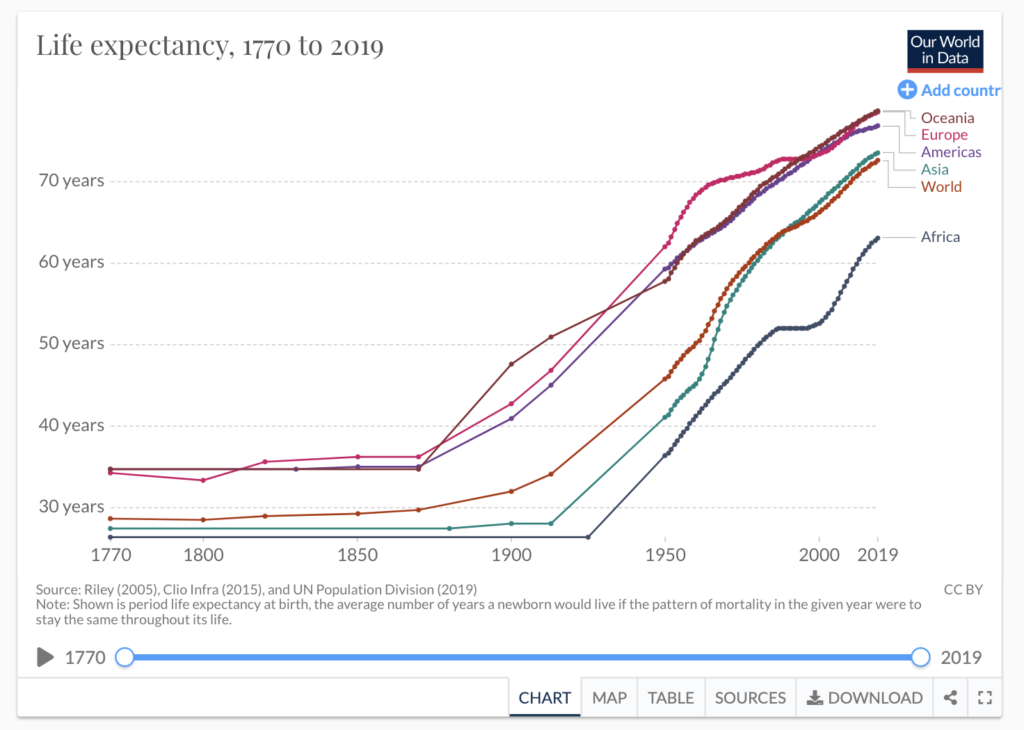Context:
The New Lancet Study shows that global life expectancy is up by 6.2 years from the years 1990 to 2021 due to declines in infectious and cardiovascular diseases
Key Findings
- Food and waterborne diseases known as enteric illnesses, which includes bacterial, parasitic, and viral infections, saw the most significant decrease in mortality rates.
- This decline contributed to a gain of 1.1 years in life expectancy from 1990 to 2021, with the most notable improvements occurring during the 1990s compared to subsequent decades.
- The decrease in deaths caused by enteric infectious diseases resulted in a notable increase of 3.1 years in life expectancy within South Asia.
- The study also revealed that the second most influential factor in increasing life expectancy was the decrease in deaths attributed to lower respiratory infections resulting in a gain of 0.9 years from 1990 to 2021.
- Similarly, a decline in chronic respiratory diseases contributed to an additional 0.5 years in life expectancy.
- East Asia particularly with improvements in mortality rates in China, played a significant role in this increased life expectancy.
- Regional disparities in life expectancy were evident, with Southeast Asia, East Asia and Oceania experiencing the highest global increase of 8.3 years in life expectancy overall.
- Remarkably, despite this, they also recorded the smallest reduction in life expectancy due to COVID-19 at 0.4 years.
- According to the Study, Bhutan experienced the most significant increase in life expectancy, with a gain of 13.6 years. Bangladesh followed closely with an increase of 13.3 years, while Nepal saw a rise of 10.4 years. In comparison, Pakistan had a more modest increase of 2.5 years in life expectancy.
- The research also discovered widespread declines in mortality rates for certain vaccine-preventable diseases like measles, with concentrations observed in specific geographic regions.
- The study highlighted that deaths of children under five due to measles were particularly concentrated in western and eastern sub-Saharan Africa.
- However, the study pointed out that digestive diseases and cirrhosis presented substantial challenges, showing no improvement from 2010 to 2019.
- Additionally, diabetes and kidney diseases contributed to a global decrease of 0.1 years in life expectancy.
• COVID-19 disruption: COVID-19 led to a decrease of 1.6 years in global life expectancy between 2019 and 2021, marking the most significant impact across all causes.
- Impact of COVID-19 on life expectancy varied widely with notable losses of 4.9 years in Andean Latin America, which contrasted with minimal change in East Asia.
- Regions with well-developed medical resources effectively managed COVID-19 cases while those with limited healthcare infrastructure struggled.
- Nevertheless, researchers emphasized that robust healthcare systems were not the sole determinant of pandemic outcomes.
India’s context
- Life expectancy serves as an estimation of the number of years an individual is expected to live which is commonly measured at birth.
- India has experienced a consistent rise in life expectancy attributed to factors like expanded public health initiatives and advancements in sanitation and hygiene.
- The female life expectancy at birth is higher at 70.7 years as compared to males which is 68.2 years as per the Sample Registration System (SRS) for the period 2014-18.
- According to the Ministry of Statistics and Programme Implementation (MoSPI), life expectancy has steadily increased since 1990, reaching 68.4 years for men and 71.1 years for women during 2015-2019.
- MoSPI projections indicate further increases to 71.2 years for men and 74.7 years for women by 2031-2036.

- Based on the latest World Health Organization (WHO) data from 2020, life expectancy in India is: Male 69.5, female 72.2, and an overall life expectancy of 70.8 years, positioning India at 117th in global life expectancy rankings.
Way forward
- The Global community needs to make sure that the treatments that have helped reduce deaths from heart disease, stroke, and other serious illnesses in rich countries are also accessible to everyone, even where resources are limited.
- We should now focus on preventing and treating these diseases, improving vaccination programs, and creating new vaccines for bugs like E. coli and norovirus, etc.
Also Read:
INDIA’S FIRST HOME-GROWN GENE (CAR-T cell) THERAPY for cancer

